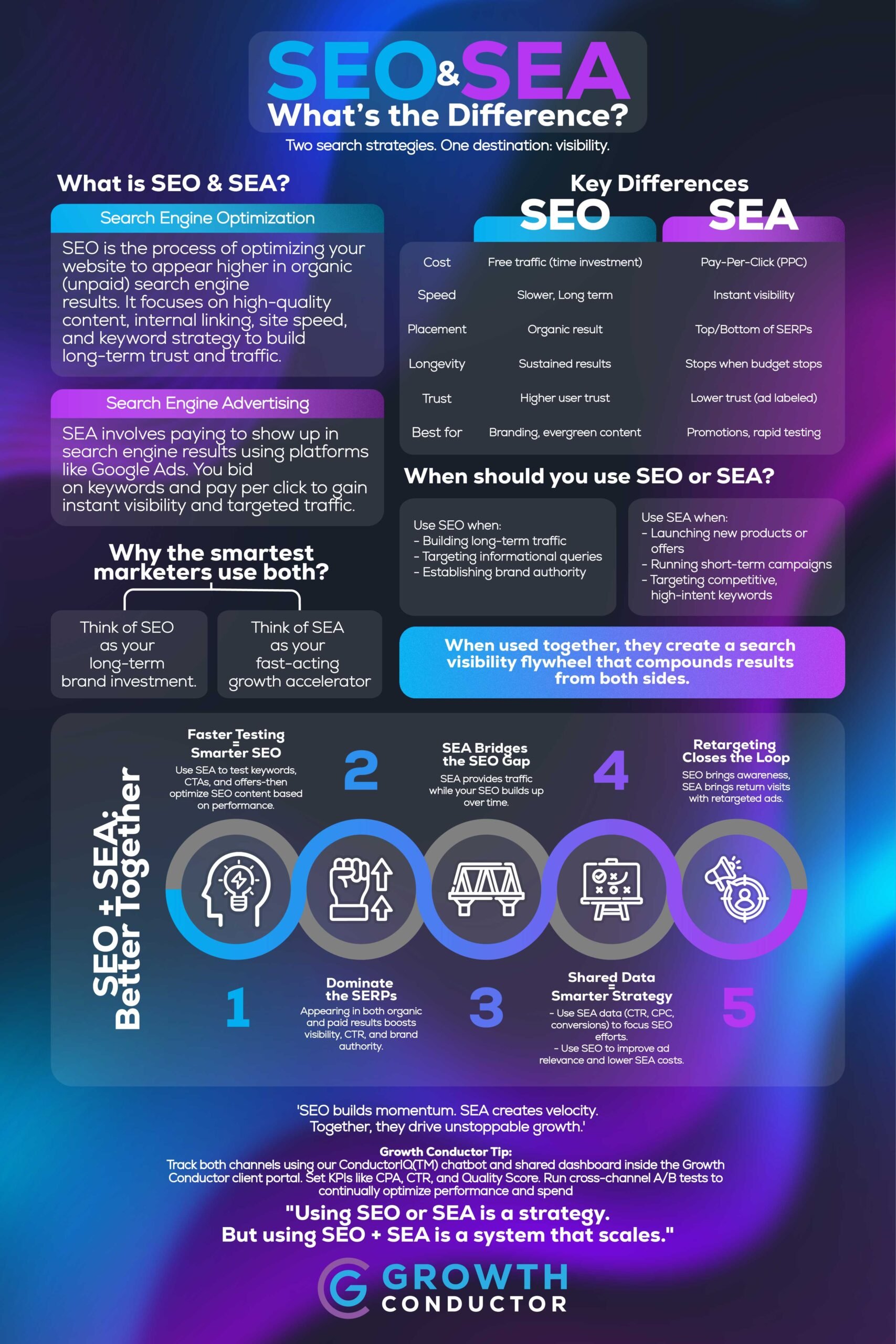Two search strategies. One destination: visibility.
If you’re wondering whether to invest in SEO or SEA, you’re asking the right question—but it’s not either-or. At Growth Conductor, we’ve helped brands scale by combining Search Engine Optimization and Search Engine Advertising into one smart, data-backed system. This guide will help you understand the difference, when to use each, and how integrating them drives growth faster than either one alone.
What Is SEO? (Search Engine Optimization)
SEO is the art and science of earning visibility in organic (unpaid) search engine results. It focuses on:
- High-quality content mapped to search intent
- Semantic keyword strategy and internal linking
- Fast site speed and mobile-first experience
- Schema markup and accessibility improvements
- Building topical authority through backlinks
SEO is your long-game strategy—compounding visibility, authority, and trust over time. For example, the baking tutorial site Sugar Geek Show scaled to over 300,000 monthly visitors using targeted blog SEO, with over 60% of their revenue coming from organic traffic. Their success, as detailed in this Semrush content marketing case study, is a testament to the long-term value of SEO for niche-driven businesses.
What Is SEA? (Search Engine Advertising)
SEA (Search Engine Advertising) uses platforms like Google Ads or Bing Ads to appear in search engine results through paid placements. You bid on keywords and pay for clicks, allowing precise targeting and real-time control.
SEA is agile, fast, and measurable—perfect for time-sensitive offers, product launches, and competitive markets. In fact, combining SEA with SEO can deliver superior outcomes, as explained in this Semrush comparison of SEO and SEM tactics, where testing ad copy and CTAs through paid channels often informs stronger organic page strategy.
Key Differences: SEO vs SEA
| Feature | SEO | SEA |
|---|---|---|
| Cost | Free traffic (time-heavy) | Paid per click (budget-driven) |
| Speed | Slower build-up | Instant traffic |
| Placement | Organic search listings | Top/bottom ad slots |
| Longevity | Long-term visibility | Ends when budget stops |
| Trust | Higher user trust | Lower (marked “Ad”) |
| Best For | Evergreen content, branding | Promotions, product launches |
When to Use SEO or SEA
Use SEO if you want to:
- Rank for informational or educational searches
- Establish long-term brand visibility
- Build topical authority and trust
Use SEA if you want to:
- Promote time-sensitive offers
- Test messaging or funnel performance
- Reach users in competitive or saturated markets
Use Both if you want to:
- Gain visibility on both paid and organic SERPs
- Use SEA insights to refine SEO strategy
- Retarget SEO visitors through SEA display or branded ads
Real-World Examples: How SEO and SEA Work Together
Brands that leverage both SEO and SEA experience an effect known as search incrementality, where the combined visibility results in higher total traffic than either strategy used alone. This phenomenon is well-documented in Search Engine Journal’s research on paid search incrementality, reinforcing the importance of an integrated approach.
The team at Semrush also found that businesses using SEA to test ad elements—like messaging and CTAs—can directly improve the performance of organic content when those learnings are applied to SEO landing pages. This cross-channel feedback loop increases ROI, reduces cost per acquisition, and improves user engagement across both channels.
Why the Smartest Marketers Use Both
1. Faster Testing = Smarter SEO
SEA allows for rapid testing of offers, language, and positioning. Once you identify what converts, apply it to your SEO titles, meta descriptions, and page content for stronger organic performance.
2. SERP Domination = Higher Click-Through Rates
When your brand appears in both paid and organic results, you gain more screen real estate—improving your visibility and credibility with users.
3. SEA Bridges the SEO Gap
SEO takes time to rank. SEA fills the visibility gap early in a campaign, especially when entering new markets or launching new products.
4. Shared Data Powers Smarter Strategy
Paid ad metrics like CTR, CPC, and conversion rates can help prioritize which keywords to target with SEO. At the same time, optimized organic pages can reduce ad costs by improving Quality Scores.
5. SEO Attracts. SEA Converts.
While SEO brings in top-of-funnel awareness, SEA helps bring those users back with retargeting ads—closing the loop and increasing conversion rates.

Growth Conductor’s Reporting and Support
At Growth Conductor, we don’t just launch campaigns—we help you understand the why behind every win.
- We deliver detailed, easy-to-read SEO and SEA performance reports
- We educate your team on what’s working, why it matters, and how to improve
- We track cross-channel KPIs to help you grow faster and smarter
With transparent reporting and ongoing education, you’ll always know how your search strategy is performing—and how to make it better.
